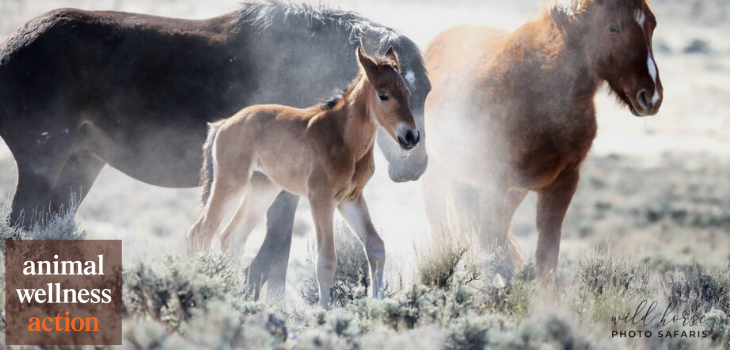Known by some as Gandalf, Old Man is the elder statesman of the Onaqui herd living in the Great Basin Desert in western Utah. Nearing 30 years, the iconic white stallion with the long, windswept mane and tail has triumphed in countless battles with other stallions for dominance, endured searing hot summers, and survived some of the most punishing winter conditions in the country. He can now be found grazing peacefully alongside other, older stallions he once counted as rivals.
But Old Man may not survive what the Bureau of Land Management has in store for him. On July 12th, BLM helicopters will stampede members of the Onaqui herd into traps to permanently, with the intent to remove nearly 300 of them from their home territories. Any horse who shows the slightest signs of lameness, illness, injury, or who even appears underweight, will be shot and killed by the BLM. Elderly and in frail health, Old Man will almost certainly lag behind the rest of the herd, and if he makes it into the trap showing his age, the BLM’s “cowboys” will have their guns ready to end his life.
Old Man and the rest of the Onaqui horses have a new champion in actress Katherine Heigl, long known as a steadfast champion for animal protection. Heigl, who owns property and keeps horses of her own in Summit County, Utah, has lent her name and her familiar face to a billboard campaign financed by the Center in the Salt Lake City area to raise awareness of the impending Onaqui roundup and call for the horses to be protected.
“With their historic place on the public lands of Utah, the Onaqui horses are living treasures that contribute to the beauty of the Great Basin Desert, as well as the economic vitality of nearby communities,” said Heigl, who lives in Summit County and keeps horses at her ranch in the Kamas Valley. “Instead of cruel helicopter roundups, I call on the Bureau of Land Management to leave the Onaqui horses on the land, manage them humanely with fertility control, and limit livestock grazing to protect the ecosystem.”
For years, advocates and admirers around the world have celebrated the exploits and struggles of the famed Onaqui wild horses in the Great Basin Desert. Known for their robust beauty and their ability to thrive in a harsh and unforgiving high desert environment, this distinctive community of horses figures prominently in the imagination of wild horse enthusiasts, whose love for the horses is reflected in positive economic benefits for surrounding communities, where they spend money on hotel rooms, restaurants, gas stations, and grocery stores.
But the BLM, which seems to have an adverse reaction to wild horses with names and with a community of followers across the world, does its best to diminish the public’s love for the horses by blaming them for damaging the rangeland. It disingenuously claims the horses will be chased down, trapped, and removed for their own good, because otherwise they might not have enough forage to survive. The agency willfully omits from its self-serving narrative that the real threat to the range isn’t a few hundred wild horses, but thousands upon thousands of cattle and sheep grazed at taxpayer expense to enrich corporate livestock producers.
A recent New York Times report reveals the BLM’s Adoption Incentive Program is being abused and that countless horses and burros are being sent to slaughter, after the agency pays the “adopter” $1,000 per horse. In short, kill buyers and their suppliers are double dipping – taking thousands of dollars from taxpayers under the assumption that they will care for horses and then grabbing additional thousands by selling them to slaughter.
The Onaqui Herd Management Area (HMA) is over 205,000 square acres in size — half as big as all of San Diego County. That amounts to one horse per 512 acres. For purposes of scale, a single, domestic horse typically requires two acres of land to provide for its food and space needs. Yet still the BLM perpetuates the lie that this vast habitat can’t support this small, vulnerable population of horses.
Nor can the BLM claim its roundup of the Onaquis is financially responsible. In 2020, the agency spent 80 percent of its total budget on helicopter roundups and off-range holding pastures. That’s nearly $64 million to remove and warehouse wild horses and burros that could be managed on public lands at a much lower cost. The BLM itself estimates that the cost of keeping one wild horse in government holding is upwards of $50,000 over the animal’s lifetime. In other words, keeping wild horses and burros on public lands and using on-range management solutions is not only more humane, but also much more cost-effective.
The plight of the Onaquis illustrates just how badly out of step the BLM is with the American public and with sound horse conservation methods. While most Americans love to see horses and burros living wild and free on the public landscape and support humane, on-the-ground management that centers on proven fertility control to regulate population growth, the BLM perpetuates a cowboy culture that views horse advocates and their passion with open disdain, and regards these national icons as little more than feral pests that must be subdued and removed from our federal lands.
